
Since we are on bodies of water this week let's go underground this time.
The USDA estimates that producers will plant 88 million acres of corn this year and 89 million acres of soybeans. This fact is stated to give you some perspective to answer today's question.
The Ogalla Aquifer, also known as the High Plains aquifer underlies how many millions of acres of land in the Plains?
It underlies land in how many states?
If the Ogallala Aquifer were the 6th Great Lake, what place would it be in for total volume of water?
Lake Superior is #1, followed by Lake Michigan, then Huron, then Ontario, then Erie.
So Great Lake Ogallala, if it existed would be in what place on the above list?
If the Ogallala Aquifer were a Great Lake, only Lake Superior would have more water. It has the amount of water that is closest in quantity to Lake Michigan, so it would be tied for #2 for the largest Great Lake.
vandy wins with his good guess that was only off by 1 place.
The High Plains aquifer, also known as the Ogallala aquifer, underlies about 112 million acres, or 175,000 square miles, in parts of eight states, including: Colorado, Kansas, Nebraska, New Mexico, Oklahoma, South Dakota, Texas and Wyoming.
This is more acreage than the entire acreage of this years planted corn or soybeans.
The first map, shows the depth of the Ogallala from 20 years ago. Only much of Nebraska is in good shape.
The 2nd map shows how much of a draw down has occurred since 1950. Outside of Nebraska the water is being depleted at an unsustainable rate.
The Southern Plains is going to have an extreme water shortage in the coming decades. Not if or might but will and the question is just how bad and how soon.

High Plains aquifer water-level changes, predevelopment (about 1950) to 2015. Figure 1 from USGS SIR 2017-5040.(Public domain.)
http://www.ce.utexas.edu/prof/maidment/grad/romanek/wtrproject/stats.htm
Mike, has there been any recent trend supporting Global Warming?
Carl,
You asked the right guy. I am thrilled to answer this outstanding question when I have my atmospheric scientist hat on later today, well after the markets close.
I will start a new thread for that one.
I grew up in Lubbock, the Hub of the South Plains, but moved to Dallas in 1984. I still have friends and family there. Wow! What are 300,000+ residents going to do now to increase the length of time before it dries up?
What will they do?
They will suffer greatly. Many will have to move, others will have to adjust to no longer having water.
The title of the story and some information in this article is not accurate including the statement about climate change (instead of Midwest, it should be Plains or Southern Plains) but it makes all the valid, profound points. We have a disaster coming up for millions that live in this area.
https://www.nationalgeographic.com/magazine/2016/08/vanishing-midwest-ogallala-aquifer-drought/
"The irrigation era may come to be called the “great pump up,” bookending the other man-made High Plains disaster—the “great plow up,” when 5.2 million acres of native grasses were torn out, setting the stage for the Dust Bowl. “A couple of generations from now,” says Burke Griggs, a water law expert who teaches at Washburn University in Topeka, “people are going to look back and say: What the hell were they thinking?"